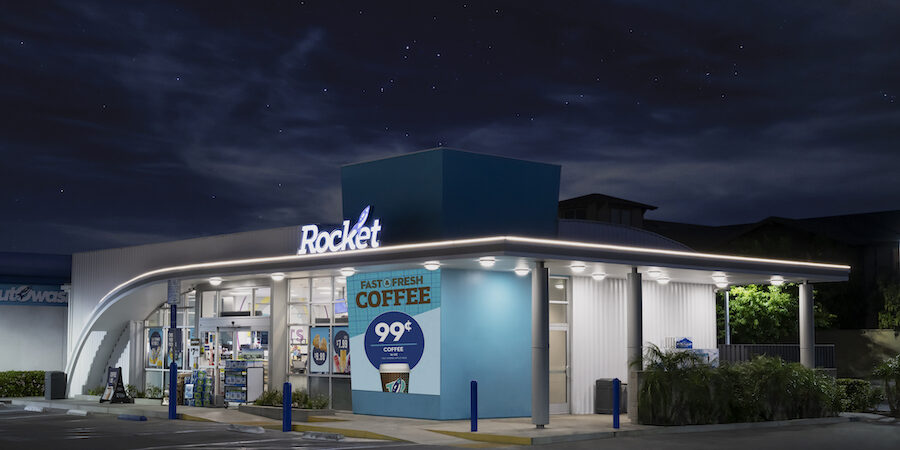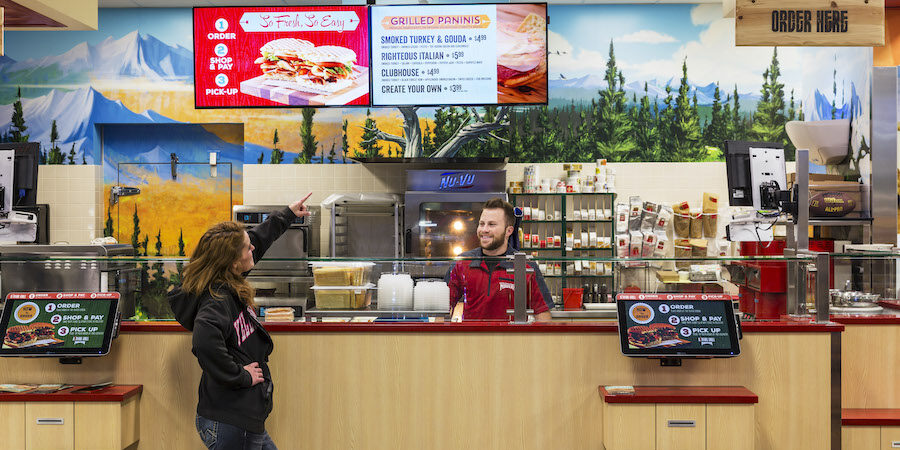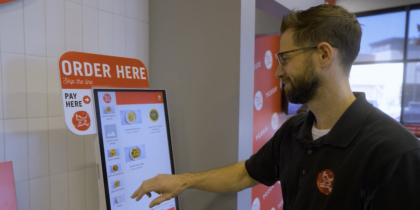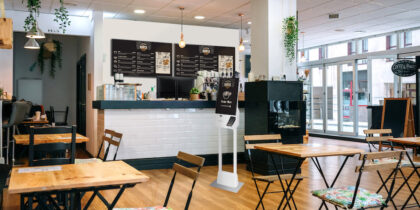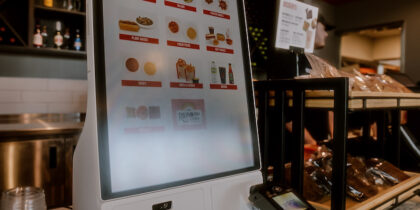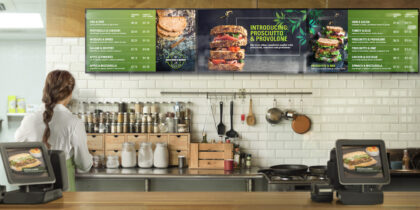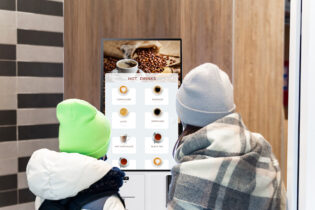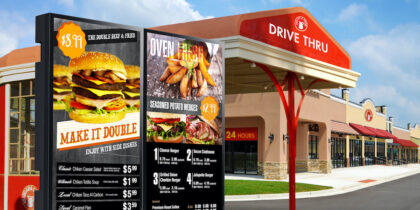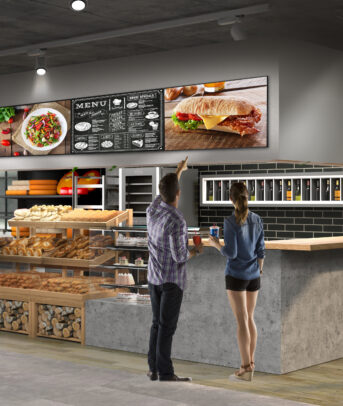Convenience stores across the United States are in the midst of a digital transformation of their entire customer experience — from relevant messaging on monument signage to mobile app integration and beacons. Throughout the forecourt and inside the store, digital signage and software solutions help with customers’ decision-making process and ultimately increase their basket size.
Convenience at the core
Convenience stores experienced record sales last year, propelled by in-store sales of more than $300 million. The high numbers continued in 2023, as 2 out of 3 retailers surveyed by the National Association of Convenience Stores (NACS) reported their sales for the first seven months of 2023 were higher than the same period last year. The robust health of the convenience store sector is underscored by a growth in store numbers. According to the 2023 NACS/Nielsen IQ Convenience Industry Store Count, there are 150,174 c-stores across the United States with the number of single-store operators up by 1,087 to a total of 90,423 stores — or 60.2% of all U.S. convenience stores.
Factoring high in the growth rate is fresh and prepared foods, providing an opportunity for digital signage to raise customer awareness of these new menu items and manage perishable inventory. For example, when there is a surplus of produce and other perishable food, the store might run a promotion or feature them as a daily special.
Digital transformation also takes in customer expectations for convenience and frictionless purchasing today, and convenience stores have adopted technology that allows customers to place orders from their phones, often by scanning a QR code outside the store. By the time their gas has been pumped, their order is ready to pick up in the store, where digital signage can direct them to their order — and upsell additional items.
Self-service kiosks, such as Samsung Windows All-In-One Kiosk, put even more control in the hands of customers. Customers can browse menus, place orders and pay in their own time, freeing up staff to focus on other key tasks and providing a range of other operational benefits. The All-In-One Kiosk comes in multiple models, too — counter, stand or wall — allowing them to fit unobtrusively almost anywhere in the store.
Relevant and personalized content
Similarly, digital signage also allows convenience stores to communicate dynamic pricing, which is especially useful for seasonal changes. As with produce, seasonal inventory, like umbrellas and cocoa, is easier to manage with digital signage, as it allows retailers to update displays on the fly, including when an item is running low on stock.
Increase basket size in the c-store
Get your free guide to digitizing convenience stores to boost sales using digital signage. Download Now
To help humanize these digital solutions, many convenience stores are linking their signage network to a loyalty program or app, sharing personalized messages and relevant coupons with customers as they arrive. Linking digital displays with loyalty programs makes great business sense in the current climate, as research by Bluedot shows 70% of consumers are willing to download apps and join loyalty programs for freebies and discounts. Tailored to specific customers, on-screen messaging can guide them through the store and help them make purchasing decisions.
Major retail brands are also helping convenience stores with their digital signage outfits. Retailers can use a convenience store’s signage network to test new products and messaging, as well as expand to new markets. These contracts between brands and franchisees are a win-win.
Convenience store technology allows stores to change the way they manage their digital signage and improve sales. Samsung VXT is a cloud-based content management system for digital signage that helps retailers better connect with the customer and personalize the shopping experience. By creating content that’s tailored to a convenience store’s specific promotion purposes, stores can boost brand awareness and drive increased sales.
Vehicle for change
Digital signage now informs consumers’ purchasing decisions both on the forecourt and in-store. Outside, window displays rotate messages of current promotions, while indoor displays direct people toward fresh food items. Self-service kiosks allow customers to scan items and learn more about them, such as nutritional information or cost.
There’s a brand image benefit to digital signage, as well. Retailers that use innovative technology are seen as cutting-edge, and they gain customer favorability, while those that don’t are thought to be less organized and lagging behind the curve. Plus, as digital signage becomes more commonplace in all types of shops, those without may lose status and trust, just as restaurants with a website will generally attract more diners than one without.
Operational wins
Digital solutions deliver savings in both labor and business purchases, streamlining formerly manual processes in both the front and back of the house. For instance, convenience stores can digitize their inventory and integrate it seamlessly with mobile apps. And with digital solutions for line busting, team members can work more efficiently.
In-store displays that are traditionally static, like lottery ticket displays, for example, can also be digitized, auto-updating the lottery jackpots as they grow in size. Reorganizing such a display with a digital solution can cut down the process from two to three hours a day to about 45 minutes.
You may imagine digital signage comes at a large upfront cost, but in terms of return on investment, the average screen pays for itself in just 45 days. Some of that comes from the fact that digital ordering systems are always ready to ask if a customer wants something else. They’re not afraid of upselling and will continue to make product recommendations, increasing the average basket size.
Solutions for the future
Convenience retailers are often cautious about the look and feel of new solutions and believe they need to be tech-savvy in order to implement a signage network. In reality, today’s solutions are easy to set up, and on-screen content is easy to customize. The latest technology allows franchisees to manage their messaging campaigns remotely, see what’s playing on-screen and change the content as needed. Samsung digital signage and software solutions can be scaled from a single c-store location to a national franchise with hundreds of locations across the country.
For those who prefer a more hands-off approach, Samsung has a team of content creators and customer service experts to help franchisees get more comfortable with digital — especially for early adopters, who are reporting a 35-40% increase in the average ticket item. With data showing an increase in c-store count, and that there is now one c-store for every 2,225 people in the U.S., it’s the perfect time for convenience stores that haven’t gone digital to make the switch — and reap the rewards.
Sign up for a VXT free trial here, and get your guide to digitizing convenience stores to boost sales using digital signage.
